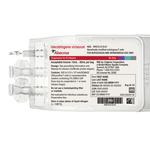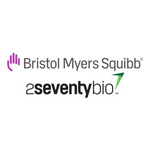PRINCETON, N.J., & CAMBRIDGE, Mass. — (BUSINESS WIRE) — $BMY #CART — Bristol Myers Squibb (NYSE: BMY) and 2seventy bio, Inc. (Nasdaq: TSVT) have announced that on April 4, 2024, the U.S. Food and Drug Administration (FDA) approved Abecma®(idecabtagene vicleucel; ide-cel) for the treatment of adult patients with relapsed or refractory multiple myeloma after two or more prior lines of therapy including an immunomodulatory agent (IMiD), a proteasome inhibitor (PI), and an anti-CD38 monoclonal antibody, based on results from the KarMMa-3 trial.
This approval expands Abecma’s indication, making it available in earlier lines to patients who have relapsed or become refractory after exposure to these three main classes of treatment (triple-class exposed), after two prior lines of therapy. Abecma is administered as a one-time infusion, with a new recommended dose range of 300 to 510 x 106 CAR-positive T cells. Please see the Important Safety Information section below, including Boxed WARNINGS for Abecma regarding Cytokine Release Syndrome, Neurologic Toxicities, Hemophagocytic Lymphohistiocytosis/Macrophage Activation Syndrome, Prolonged Cytopenia, and Secondary Hematological Malignancies.
“Abecma has demonstrated a progression-free survival benefit three times that of standard regimens in relapsed or refractory multiple myeloma, and we are now bringing the promise of cell therapy to patients earlier in their treatment journey,” said Bryan Campbell, senior vice president, Head of Commercial, Cell Therapy, Bristol Myers Squibb. “This approval underpins our commitment to addressing the unmet needs of more patients living with multiple myeloma by improving upon the current treatment paradigm, and we remain steadfast in our pursuit of innovation and advancing cell therapy research to deliver potentially transformative therapies.”

“We are extremely pleased that Abecma will be available to many more patients in the U.S.,” said Chip Baird, chief executive officer, 2seventy bio. “This approval represents another important milestone for patients, for Abecma, and for 2seventy bio as we remain committed to increasing treatment options and working to improve outcomes for patients living with multiple myeloma.”

Despite advances in treatment, multiple myeloma remains an incurable disease characterized by periods of remission and relapse. In early lines of treatment, regimens consisting of combinations of IMiDs, PIs, and anti-CD38 monoclonal antibodies are often used to help manage the disease. Unfortunately, as many patients go on to relapse and/or become refractory to these classes of therapy, more patients are becoming triple-class exposed earlier in their treatment journey. There are limited options for these patients, and triple-class exposed relapsed and/or refractory multiple myeloma is associated with poor outcomes and a median progression-free survival (PFS) of three to five months. In this patient population with high unmet need, Abecma has demonstrated clinically meaningful and statistically significant improvements in PFS (95% CI: 13.3 months vs. 4.4 months [HR: 0.49; p<0.0001]). In addition, Abecma exhibited a well-established safety profile with mostly low-grade cytokine release syndrome and neurotoxicity. No cases of Parkinsonism were reported in the study.
“The results of the KarMMa-3 study are remarkable, especially given the historic outcomes with standard regimens for these patients with relapsed or refractory disease,” said Al-Ola A. Abdallah, M.D., University of Kansas, Clinical Associate Professor, Clinical Director, Hematologic Malignancies and Cellular Therapeutics and chair of U.S. Myeloma Innovations Research Collaborative. “With this approval, these patients now have an opportunity to be treated at an earlier line of therapy with a potentially transformative therapy that offers significantly improved progression-free survival for this difficult-to-treat disease that has had no established treatment approach.”
To support this approval and future expansions, Bristol Myers Squibb has made continuous investments to increase manufacturing capacity and has shown a consistently high manufacturing success rate of 94% for Abecma in the commercial setting.
Abecma was recently approved in Japan, Switzerland and the European Union for adult patients with triple-class exposed relapsed and/or refractory multiple myeloma after two prior lines of therapy, making it the only CAR T cell therapy available globally for earlier lines of therapy for patients with triple-class exposed relapsed and/or refractory multiple myeloma. Abecma is also currently approved in Great Britain and Israel for adult patients with triple-class exposed relapsed and refractory multiple myeloma after three or more prior lines of therapy.
KarMMa-3 Pivotal Trial Results
The KarMMa-3 trial is a pivotal, Phase 3, open-label, global, randomized, controlled trial evaluating Abecma compared to standard regimens in patients with relapsed and refractory multiple myeloma who have received two to four prior lines of treatment, including an immunomodulatory agent, a proteasome inhibitor, and an anti-CD38 antibody, and were refractory to the last treatment regimen, with 94% of patients with disease refractory to prior treatment with daratumumab. KarMMa-3 is the only Phase 3 trial to evaluate a CAR T cell therapy in a patient population consisting entirely of triple-class exposed relapsed and refractory multiple myeloma patients. The trial’s patient-centric design allowed for crossover from standard regimens to Abecma upon confirmed disease progression. At the time of the final progression-free survival (PFS) analysis, more than half (56%) of patients in the standard regimens arm crossed over to receive Abecma as a subsequent therapy.
In the study, 254 patients were randomized to receive Abecma and 132 were randomized to receive standard regimens that consisted of combinations that included daratumumab, pomalidomide, and dexamethasone (DPd), daratumumab, bortezomib, and dexamethasone (DVd), ixazomib, lenalidomide, and dexamethasone (IRd), carfilzomib and dexamethasone (Kd) or elotuzumab, pomalidomide and dexamethasone (EPd) chosen based on their most recent treatment regimen and investigator discretion. In the Abecma arm, pretreatment consisted of leukapheresis and optional bridging therapy. The choice to use bridging therapy was at the discretion of the investigator.
At an estimated median duration of follow-up of 15.9 months at the primary PFS analysis, Abecma more than tripled the primary endpoint of PFS compared with standard regimens, with a median PFS of 13.3 months (95% CI: 11.8-16.1) vs. 4.4 months (95% CI: 3.4-5.9), respectively (HR:0.49; 95% CI: 0.38-0.64; p<0.0001), representing a 51% reduction in the risk of disease progression or death with Abecma. Abecma also showed a significant improvement in overall response rates (p<0.0001) with the majority (71%) of patients treated with Abecma achieving a response, and 39% achieving a complete or stringent complete response. In comparison, less than half of patients (42%) who received standard regimens achieved a response, with 5% experiencing a complete response or stringent complete response. Responses were durable with Abecma, with a median duration of response of 14.8 months (95% CI: 12.0-18.6). In those patients who derived a complete response or better, median duration of response was 20 months (95% CI: 15.8-24.3).
Abecma has exhibited a well-established and consistent safety profile with mostly low-grade cytokine release syndrome (CRS) and neurotoxicity. Among patients who received Abecma in the KarMMa and KarMMa-3 studies (n=349), any grade CRS occurred in 89% of patients, including Grade >3 CRS in 7% of patients, and three cases (0.9%) of Grade 5 CRS reported. The median time to onset of CRS was 1 day (range: 1-27 days), and the median duration of CRS was 5 days (range: 1-63 days). Any grade neurotoxicity occurred in 40% of patients treated with Abecma in the KarMMa and KarMMa-3 studies, including Grade 3 neurotoxicity in 4% of patients, and two cases (0.6%) of Grade 4 neurotoxicity reported. At the safety update for KarMMa-3, one case of Grade 5 neurotoxicity was reported. The median time to onset of neurotoxicity was 2 days (range: 1-148 days), and the median duration of neurotoxicity was 8 days (range: 1-720 days).
About Abecma
Abecma is a CAR T cell therapy that recognizes and binds to BCMA on the surface of multiple myeloma cells leading to CAR T cell proliferation, cytokine secretion, and subsequent cytolytic killing of BCMA-expressing cells. Abecma is being jointly developed and commercialized in the U.S. as part of a Co-Development, Co-Promotion, and Profit Share Agreement between Bristol Myers Squibb and 2seventy bio.
This approval further underscores Bristol Myers Squibb’s deep knowledge and experience in cell therapy science and continued clinical advancements for multiple myeloma patients. The companies’ broad clinical development program for Abecma includes ongoing and planned clinical studies (KarMMa-2, KarMMa-3, KarMMa-9) for patients with multiple myeloma. For more information visit clinicaltrials.gov.
U.S. Important Safety Information
BOXED WARNING: CYTOKINE RELEASE SYNDROME, NEUROLOGIC TOXICITIES, HLH/MAS, PROLONGED CYTOPENIA and SECONDARY HEMATOLOGICAL MALIGNANCIES
- Cytokine Release Syndrome (CRS), including fatal or life-threatening reactions, occurred in patients following treatment with ABECMA. Do not administer ABECMA to patients with active infection or inflammatory disorders. Treat severe or life-threatening CRS with tocilizumab or tocilizumab and corticosteroids.
- Neurologic Toxicities, which may be severe or life-threatening, occurred following treatment with ABECMA, including concurrently with CRS, after CRS resolution, or in the absence of CRS. Monitor for neurologic events after treatment with ABECMA. Provide supportive care and/or corticosteroids as needed.
- Hemophagocytic Lymphohistiocytosis/Macrophage Activation Syndrome (HLH/MAS) including fatal and life-threatening reactions, occurred in patients following treatment with ABECMA. HLH/MAS can occur with CRS or neurologic toxicities.
- Prolonged Cytopenia with bleeding and infection, including fatal outcomes following stem cell transplantation for hematopoietic recovery, occurred following treatment with ABECMA.
- T cell malignancies have occurred following treatment of hematologic malignancies with BCMA- and CD19-directed genetically modified autologous T cell immunotherapies, including ABECMA
- ABECMA is available only through a restricted program under a Risk Evaluation and Mitigation Strategy (REMS) called the ABECMA REMS.
Warnings and Precautions:
Early Death: In KarMMa-3, a randomized (2:1), controlled trial, a higher proportion of patients experienced death within 9 months after randomization in the ABECMA arm (45/254; 18%) compared to the standard regimens arm (15/132; 11%). Early deaths occurred in 8% (20/254) and 0% prior to ABECMA infusion and standard regimen administration, respectively, and 10% (25/254) and 11% (15/132) after ABECMA infusion and standard regimen administration, respectively. Out of the 20 deaths that occurred prior to ABECMA infusion, 15 occurred from disease progression, 3 occurred from adverse events and 2 occurred from unknown causes. Out of the 25 deaths that occurred after ABECMA infusion, 10 occurred from disease progression, 11 occurred from adverse events, and 4 occurred from unknown causes.
Cytokine Release Syndrome (CRS): CRS, including fatal or life-threatening reactions, occurred following treatment with ABECMA. Among patients receiving ABECMA for relapsed refractory multiple myeloma in the KarMMa and KarMMa-3 studies (N=349), CRS occurred in 89% (310/349), including ≥ Grade 3 CRS (Lee grading system) in 7% (23/349) of patients and Grade 5 CRS in 0.9% (3/349) of patients. The median time-to-onset of CRS, any grade, was 1 day (range: 1 to 27 days), and the median duration of CRS was 5 days (range: 1 to 63 days). In the pooled studies, the rate of ≥Grade 3 CRS was 10% (7/71) for patients treated in dose range of 460 to 510 x 106 CAR-positive T cells and 5.4% (13/241) for patients treated in dose range of 300 to 460 x 106 CAR-positive T cells.
The most common manifestations of CRS (greater than or equal to 10%) included pyrexia (87%), hypotension (30%), tachycardia (26%), chills (19%), hypoxia (16%). Grade 3 or higher events that may be associated with CRS include hypotension, hypoxia, hyperbilirubinemia, hypofibrinogenemia, ARDS, atrial fibrillation, hepatocellular injury, metabolic acidosis, pulmonary edema, coagulopathy, renal failure, multiple organ dysfunction syndrome and HLH/MAS.
Identify CRS based on clinical presentation. Evaluate for and treat other causes of fever, hypoxia, and hypotension. CRS has been reported to be associated with findings of HLH/MAS, and the physiology of the syndromes may overlap. HLH/MAS is a potentially life-threatening condition. In patients with progressive symptoms of CRS or refractory CRS despite treatment, evaluate for evidence of HLH/MAS.
Of the 349 patients who received ABECMA in clinical trials, 226 (65%) patients received tocilizumab; 39% (135/349) received a single dose, while 26% (91/349) received more than 1 dose of tocilizumab. Overall, 24% (82/349) of patients received at least 1 dose of corticosteroids for treatment of CRS. Almost all patients who received corticosteroids for CRS also received tocilizumab. For patients treated in dose range of 460 to 510 x 106 CAR-positive T cells, 76% (54/71) of patients received tocilizumab and 35% (25/71) received at least 1 dose of corticosteroids for treatment of CRS. For patients treated in dose range of 300 to 460 x 106 CAR-positive T cells, 63% (152/241) of patients received tocilizumab and 20% (49/241) received at least 1 dose of corticosteroid for treatment of CRS.
Monitor patients at least daily for 7 days following ABECMA infusion at the REMS-certified healthcare facility for signs or symptoms of CRS and monitor patients for signs or symptoms of CRS for at least 4 weeks after ABECMA infusion. At the first sign of CRS, institute treatment with supportive care, tocilizumab and/or corticosteroids as indicated. Ensure that a minimum of 2 doses of tocilizumab are available prior to infusion of ABECMA. Counsel patients to seek immediate medical attention should signs or symptoms of CRS occur at any time.
Neurologic Toxicities: Neurologic toxicities, including immune-effector cell-associated neurotoxicity (ICANS), which may be severe or life- threatening, occurred concurrently with CRS, after CRS resolution, or in the absence of CRS following treatment with ABECMA.
In patients receiving ABECMA in the KarMMa and KarMMa-3 studies, CAR T cell-associated neurotoxicity occurred in 40% (139/349), including Grade 3 in 4% (14/349) and Grade 4 in 0.6% (2/349) of patients. The median time to onset of neurotoxicity was 2 days (range: 1 to 148 days). The median duration of CAR T cell-associated neurotoxicity was 8 days (range: 1 to 720 days) in all patients including those with ongoing neurologic events at the time of death or data cut off. CAR T cell-associated neurotoxicity resolved in 123 of 139 (88%) patients and median time to resolution was 5 days (range: 1 to 245 days). One-hundred and thirty four out of 349 (38%) patients with neurotoxicity had CRS. The onset of neurotoxicity during CRS was observed in 93 patients, before the onset of CRS in 12 patients, and after the CRS event in 29 patients. The rate of Grade 3 or 4 CAR T cell-associated neurotoxicity was 5.6% (4/71) and 3.7% (9/241) for patients treated in dose range of 460 to 510 x 106 CAR-positive T cells and 300 to 460 x 106 CAR-positive T cells, respectively. The most frequent (greater than or equal to 5%) manifestations of CAR T cell-associated neurotoxicity include encephalopathy (21%), headache (15%), dizziness (8%), delirium (6%), and tremor (6%).
At the safety update for KarMMa-3 study, one patient developed fatal neurotoxicity 43 days after ABECMA. In KarMMa, one patient had ongoing Grade 2 neurotoxicity at the time of death. Two patients had ongoing Grade 1 tremor at the time of data cutoff.
Cerebral edema has been associated with ABECMA in a patient in another study in multiple myeloma. Grade 3 myelitis and Grade 3 parkinsonism have occurred after treatment with ABECMA in another study in multiple myeloma.
Monitor patients at least daily for 7 days following ABECMA infusion at the REMS-certified healthcare facility for signs or symptoms of neurologic toxicities and monitor patients for signs or symptoms of neurologic toxicities for at least 4 weeks after ABECMA infusion and treat promptly. Rule out other causes of neurologic symptoms. Neurologic toxicity should be managed with supportive care and/or corticosteroids as needed. Counsel patients to seek immediate medical attention should signs or symptoms occur at any time.
Hemophagocytic Lymphohistiocytosis (HLH)/Macrophage Activation Syndrome (MAS): In patients receiving ABECMA in the KarMMa and KarMMa-3 studies, HLH/MAS occurred in 2.9% (10/349) of patients. All events of HLH/MAS had onset within 10 days of receiving ABECMA, with a median onset of 6.5 days (range: 4 to 10 days) and occurred in the setting of ongoing or worsening CRS. Five patients with HLH/MAS had overlapping neurotoxicity. The manifestations of HLH/MAS include hypotension, hypoxia, multiple organ dysfunction, renal dysfunction and cytopenia.
In KarMMa-3, one patient had Grade 5, two patients had Grade 4 and two patients had Grade 3 HLH/MAS. The patient with Grade 5 HLH/MAS also had Grade 5 candida sepsis and Grade 5 CRS. In another patient who died due to stroke, the Grade 4 HLH/MAS had resolved prior to death. Two cases of Grade 3 and one case of Grade 4 HLH/MAS had resolved.
In KarMMa, one patient treated in the 300 x 106 CAR-positive T cells dose cohort developed fatal multi-organ HLH/MAS with CRS. In another patient with fatal bronchopulmonary aspergillosis, HLH/MAS was contributory to the fatal outcome. Three cases of Grade 2 HLH/MAS resolved.
HLH/MAS is a potentially life-threatening condition with a high mortality rate if not recognized early and treated. Treatment of HLH/MAS should be administered per institutional guidelines.
ABECMA REMS: Due to the risk of CRS and neurologic toxicities, ABECMA is available only through a restricted program under a Risk Evaluation and Mitigation Strategy (REMS) called the ABECMA REMS. Further information is available at www.AbecmaREMS.com or contact Bristol-Myers Squibb at 1-866-340-7332.
Hypersensitivity Reactions: Allergic reactions may occur with the infusion of ABECMA. Serious hypersensitivity reactions, including anaphylaxis, may be due to dimethyl sulfoxide (DMSO) in ABECMA.
Infections: ABECMA should not be administered to patients with active infections or inflammatory disorders. Severe, life-threatening, or fatal infections occurred in patients after ABECMA infusion.
In all patients receiving ABECMA in the KarMMa and KarMMa-3 studies, infections (all grades) occurred in 61% of patients. Grade 3 or 4 infections occurred in 21% of patients. Grade 3 or 4 infections with an unspecified pathogen occurred in 12%, viral infections in 7%, bacterial infections in 4.3%, and fungal infections in 1.4% of patients. Overall, 15 patients had Grade 5 infections (4.3%); 8 patients (2.3%) with infections of pathogen unspecified, 3 patients (0.9%) with fungal infections, 3 patients (0.9%) with viral infections, and 1 patient (0.3%) with bacterial infection.
Monitor patients for signs and symptoms of infection before and after ABECMA infusion and treat appropriately. Administer prophylactic, pre-emptive, and/or therapeutic antimicrobials according to standard institutional guidelines.
Febrile neutropenia was observed in 38% (133/349) of patients after ABECMA infusion and may be concurrent with CRS. In the event of febrile neutropenia, evaluate for infection and manage with broad-spectrum antibiotics, fluids, and other supportive care as medically indicated.
Viral Reactivation: Cytomegalovirus (CMV) infection resulting in pneumonia and death has occurred following ABECMA administration. Monitor and treat for CMV reactivation in accordance with clinical guidelines. Hepatitis B virus (HBV) reactivation, in some cases resulting in fulminant hepatitis, hepatic failure, and death, can occur in patients treated with drugs directed against plasma cells. Perform screening for CMV, HBV, hepatitis C virus (HCV), and human immunodeficiency virus (HIV) in accordance with clinical guidelines before collection of cells for manufacturing. Consider antiviral therapy to prevent viral reactivation per local institutional guidelines/clinical practice.
Prolonged Cytopenias: In patients receiving ABECMA in the KarMMa and KarMMa-3 studies, 40% of patients (139/349) experienced prolonged Grade 3 or 4 neutropenia and 42% (145/349) experienced prolonged Grade 3 or 4 thrombocytopenia that had not resolved by Month 1 following ABECMA infusion. In 89% (123/139) of patients who recovered from Grade 3 or 4 neutropenia after Month 1, the median time to recovery from ABECMA infusion was 1.9 months. In 76% (110/145) of patients who recovered from Grade 3 or 4 thrombocytopenia, the median time to recovery was 1.9 months. Five patients underwent stem cell therapy for hematopoietic reconstitution due to prolonged cytopenia. The rate of Grade 3 or 4 thrombocytopenia was 62% (44/71) and 56% (135/241) for patients treated in dose range of 460 to 510 x 106 CAR-positive T cells and 300 to 460 x 106 CAR-positive T cells, respectively.
Monitor blood counts prior to and after ABECMA infusion. Manage cytopenia with myeloid growth factor and blood product transfusion support according to local institutional guidelines.
Hypogammaglobulinemia: In all patients receiving ABECMA in the KarMMa and KarMMa-3 studies, hypogammaglobulinemia was reported as an adverse event in 13% (46/349) of patients; laboratory IgG levels fell below 500 mg/dL after infusion in 37% (130/349) of patients treated with ABECMA.
Hypogammaglobulinemia either as an adverse reaction or laboratory IgG level below 500 mg/dL after infusion occurred in 45% (158/349) of patients treated with ABECMA. Forty-one percent of patients received intravenous immunoglobulin (IVIG) post-ABECMA for serum IgG <400 mg/dL.
Monitor immunoglobulin levels after treatment with ABECMA and administer IVIG for IgG <400 mg/dl. Manage appropriately per local institutional guidelines, including infection precautions and antibiotic or antiviral prophylaxis.
Use of Live Vaccines: The safety of immunization with live viral vaccines during or after ABECMA treatment has not been studied.
Contacts
Bristol Myers Squibb
Media Inquiries:
media@bms.com
Investors:
investor.relations@bms.com
2seventy bio
Investors:
Elizabeth Pingpank
860-463-0469
elizabeth.pingpank@2seventybio.com
Media:
Jenn Snyder
617-448-0281
jenn.snyder@2seventybio.com
Read full story here














